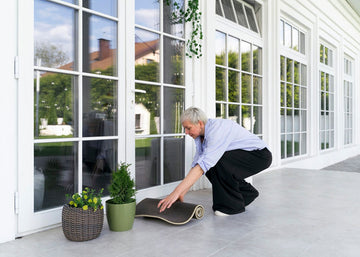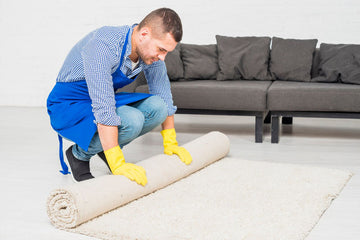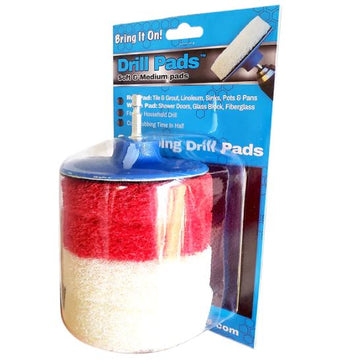The battle against dirt and clutter doesn't stop at your front door but extends to your porch and garage too. If you've been struggling to maintain a clean, organized porch and garage amidst the chaos of everyday life, this blog post is just what you need.
Here, we will arm you with effective cleaning tips, maintenance hacks, and creative organization ideas to not only keep these spaces squeaky clean but also spruce up their aesthetics. A spotless home isn't complete without a pristine porch and an immaculate garage! So roll up your sleeves and get ready to transform these overlooked areas into well-kept extensions of your put-together home!
Our article, "Porch and Garage Cleaning Tips for Spotless Home", provides several effective tips for maintaining clean porches and garages. This includes decluttering the space, sweeping or vacuuming regularly, wiping down surfaces with a damp cloth, utilizing storage containers or shelves to keep items organized, and pressure washing when necessary.
We also provide specific recommendations, such as using herbs for pest control around the patio or setting up a separate bird area to prevent birds from coming to the porch. Whether you're tackling a spring clean-up or simply maintaining your space all year round, our tips will help you achieve a spotless home.
Practical Porch Cleaning Tips
Having a clean and well-maintained porch is not only visually pleasing but also contributes to the overall cleanliness and curb appeal of your home. Here are some practical porch cleaning tips to help you achieve a spotless and inviting entrance:

- Vacuum Window Screens and Wipe Down Window Sills: Over time, window screens accumulate dust, pollen, and other debris. Use a vacuum with a drill brush attachment to remove the buildup from both sides of the screen. Additionally, wipe down the window sills to remove any dirt or grime that may have accumulated.
- Wash Windows with Glass Cleaner: Clean windows can instantly make a porch look brighter and more welcoming. Use a glass cleaner and a microfiber cloth or squeegee to clean both the inside and outside surfaces of your windows. Don't forget to dry them thoroughly to avoid streaks.
- Wash Outside Doors: Porch doors can get dirty from exposure to the elements. Mix a solution of mild detergent or vinegar with water and use a sponge or soft brush to scrub the doors gently. Rinse with clean water and let them air dry.
- Sweep and Clean Off the Porch: Regular sweeping helps remove leaves, dirt, and debris from your porch. Use a stiff broom or a leaf blower for larger areas. After sweeping, use warm soapy water or an all-purpose cleaner to scrub away any stubborn stains or marks on the surface.
- Wash Outside of Basement Windows: If you have basement windows that are visible from the porch, take the time to clean them as well. Use a hose with an adjustable nozzle or a pressure washer on low setting to spray off any dirt or grime.
- Attach Power Nozzle to Garden Hose for Cleaning Garbage Containers and Recycling Bins: Garbage containers and recycling bins can become dirty over time. Attach a power nozzle to your garden hose to effectively clean and remove any odors. Use a mild detergent or vinegar solution if needed.
- Spray Down Driveway, Walkway, Retaining Walls, Fences, Cement Porches, and Patios: Use a pressure washer or hose with an adjustable nozzle to spray down these outdoor surfaces. This will help remove dirt, algae, and stains, leaving them looking fresh and clean.
By following these practical porch cleaning tips, you can maintain a clean and inviting space that enhances the overall appearance of your home.
- According to the EPA, an average American individual generates around 4.9 pounds of trash per day, a significant portion of which can be found lingering in garages and porches if not correctly managed.
- A survey from the National Association of Professional Organizers revealed that 50% of homeowners named the garage as the most cluttered space in their homes.
- According to a study by Saint Louis University, regular cleaning including spaces like porches and garages can reduce stress levels and improve mental health.
Sweeping and Scrubbing Methods
When it comes to keeping your porch pristine, sweeping and scrubbing are essential tasks that require proper methods to ensure effective cleaning. Here's a guide on the best sweeping and scrubbing methods for your porch:

- Sweeping: Start by removing any furniture or objects from the porch to make it easier to access all areas. Begin sweeping from one corner of the porch, working your way towards the opposite side. Use long strokes and overlap each stroke slightly to cover the entire surface. Pay special attention to corners, crevices, and any areas where dirt tends to accumulate. For stubborn debris or dried leaves stuck in small gaps, use a small brush or broom to dislodge them before sweeping.
- Scrubbing: Before scrubbing your porch, sweep or brush away loose dirt and debris. Depending on the material of your porch surface (such as wood or concrete), choose an appropriate cleaning solution. For wood porches, mild soapy water or specialized wood cleaners work well. Concrete porches may benefit from a mixture of warm water and mild detergent or an alkaline-based cleaner for more stubborn stains. Apply the chosen solution using a stiff brush or scrub brush in circular motions to lift away dirt and grime. Rinse thoroughly with clean water after scrubbing.
Remember to wear protective gloves and, if applicable, eye protection when using cleaning solutions or strong detergents. Always consult manufacturer recommendations or professional advice for specific porch materials to avoid damage.
Regularly incorporating these sweeping and scrubbing methods into your porch cleaning routine will help maintain a clean and welcoming space for you and your guests to enjoy.
Ensuring Clean Windows and Doors
When it comes to maintaining a spotless home, clean windows and doors play a crucial role in creating a welcoming and visually appealing atmosphere. Not only do they enhance the curb appeal of your property, but they also allow natural light to flood into your living spaces. However, keeping these areas clean can be a challenge, especially when faced with outdoor dirt, grime, and weather conditions. To ensure sparkling windows and doors, here are some effective strategies to consider.
First and foremost, regular cleaning is key to maintaining clean windows and doors. Dusting the surfaces with a microfiber cloth or duster helps remove loose dirt and debris. Using a homemade mixture of vinegar and water or a commercial glass cleaner, spray the solution onto the glass surface and wipe it clean with a lint-free cloth or newspaper for streak-free results. Remember to clean both the inside and outside of windows for a thorough cleaning.
Next, pay attention to the often neglected components: window screens and sills. Vacuuming window screens with a brush attachment eliminates dust particles that settle on them over time. Cleaning window sills regularly prevents dirt buildup and ensures smooth operation of windows. Use a mild detergent solution or multipurpose cleaner along with a soft brush to scrub away dirt and grime from these areas.
In addition, don't overlook the importance of cleaning outside doors. Over time, doors can accumulate dust, pollen, and other outdoor pollutants. Think of it like washing your car – when your door becomes dirty, it can detract from the overall appearance of your home. Regularly wiping down doors with a damp cloth or sponge helps keep them looking fresh and inviting. If you have glass panels on your doors, follow the same cleaning process as mentioned earlier for windows.

Read this Guide For Cleaning Windows Without Streaks.
Finally, prevention goes hand in hand with cleaning when it comes to maintaining clean windows and doors. Invest in quality mats or rugs to place in front of doors and windows to prevent dirt and debris from being tracked inside. This simple step can greatly reduce the amount of cleaning required for these areas.
Remember, clean windows and doors not only make your home look more appealing, but they also allow natural light to fill your living spaces, creating a brighter and more inviting atmosphere. By following these effective strategies and incorporating them into your regular cleaning routine, you can ensure that your windows and doors remain spotless year-round.
Effective Garage Cleaning Strategies
For many homeowners, the garage serves as a storage space, workshop, or even an extension of the home itself. However, it often becomes a catch-all for clutter and chaos. To regain control over this valuable space and maintain an organized and spotless garage, it's important to implement effective cleaning strategies.
One of the first steps in cleaning your garage is decluttering. Take an inventory of items stored in your garage and sort them into categories such as keep, donate/sell, or discard. Removing unnecessary items will not only free up valuable space but also make it easier to clean. Consider hosting a garage sale or donating unwanted items to charity.
Once you've decluttered, it's time to tackle the cleaning process. Start by sweeping or vacuuming the floor to remove loose dirt and debris. If there are oil stains on the floor, apply an absorbent material like cat litter or baking soda to soak up the oil before scrubbing with a suitable degreaser. For stubborn stains, you may need a pressure washer or specialized cleaning products.
Next, focus on organizing your belongings. Invest in sturdy shelving units or cabinets to store frequently used items in an orderly manner. Utilize labeled storage bins or containers for smaller items, tools, or seasonal decor. Wall-mounted hooks or pegboards are also handy for storing garden tools, sporting equipment, or bicycles. Remember to store hazardous materials such as paint or chemicals in a secure and well-ventilated area.
Just like organizing your closet, keeping an organized garage is all about finding a designated place for each item.
Lastly, don't forget about regular maintenance and cleanliness. Regularly dust off surfaces, wipe down shelves and cabinets, and vacuum any cobwebs that may accumulate. It's also important to periodically check for pest infestations or signs of moisture buildup to address these issues promptly.
By implementing these effective garage cleaning strategies and staying proactive with organization and maintenance, you can transform your garage into a clean and functional space that adds value to your home.

Organizing and Disposing Waste
A clean and organized porch and garage not only enhance the aesthetic appeal of your home but also create a pleasant and inviting space for relaxation and storage. When it comes to organizing and disposing of waste in these areas, there are a few essential tips to keep in mind.
Start by designating specific areas or bins for different types of waste. This can include separate containers for recycling, composting, and regular trash. Clearly label each container to avoid confusion and encourage proper disposal.
For instance, you can have a designated bin for recyclable items like plastic bottles, paper, and aluminum cans. Another bin can be used for composting organic waste such as food scraps and yard trimmings. Lastly, have a trash bin specifically for non-recyclable and non-compostable waste.
When it comes to disposing of hazardous materials such as paint cans or batteries, make sure to follow local regulations on how to properly dispose of these items. Many communities have special collection sites or days where you can drop off these materials safely.
Additionally, it's important to regularly empty and clean these containers to prevent unpleasant odors or pests from being attracted to your porch or garage. Once a week or as needed, take the time to empty the trash, recycling, and compost bins into their respective outdoor trash cans or larger bins designated for pickup.
To avoid any mess or spills when moving waste from the porch or garage to the outdoor bins, consider using garbage bags that are durable and leak-proof. This will help contain any potential odors or liquids that may be present.
Additionally, if you have larger items such as furniture or appliances that need to be disposed of, check with your local municipality about bulk item pick-up or other disposal options. Some communities offer specific days where you can request pick-up of oversized items or provide drop-off locations for these items.
Don't forget about the importance of proper recycling. Make sure to familiarize yourself with what can and cannot be recycled in your area, and rinse out any containers before placing them in the recycling bin. This small step ensures that your recyclables are clean and free from contaminants, ultimately contributing to a more successful recycling process.
Now that we have covered tips for organizing and disposing waste, let's move on to maintaining outdoor furnishing and accessories.
- Proper waste management in your porch and garage involves designating specific areas or bins for different types of waste, regularly emptying and cleaning these containers, using leak-proof garbage bags, and following local regulations on disposing of hazardous materials. Additionally, it's important to familiarize yourself with what can and cannot be recycled in your area, and properly rinse out any containers before placing them in the recycling bin. Proper waste management will not only enhance the aesthetic appeal of your home but also create a pleasant and inviting space for relaxation and storage.
Maintaining Outdoor Furnishing and Accessories
Your porch and garage may be home to various outdoor furnishings and accessories like patio furniture, rugs, cushions, and decorative elements. To ensure their longevity and a fresh appearance, it's important to implement regular maintenance practices.
Think of it like taking care of your own belongings – just as you would clean your favorite dress or polish your prized silverware, maintaining outdoor furnishings helps preserve their beauty and functionality.
Start by regularly cleaning your outdoor furniture using mild soap and water or a specialized cleaner designed for the material. Wipe down the surfaces, paying attention to any nooks or crevices where dirt may accumulate. For fabric cushions or pillows, check the manufacturer's instructions for cleaning recommendations.
It's also a good idea to inspect your furniture for any signs of damage or wear. Fix loose screws or tighten bolts if needed. If you notice mold or mildew growth, address it promptly by using a mixture of water and vinegar or a mildew remover recommended for the specific material.
Consider storing cushions or other fabric elements indoors when not in use, especially during inclement weather or extended periods of non-use. This protects them from excessive sun exposure, moisture, and potential damage from pests.
|
Material |
Cleaning Tips |
|
Wood |
Clean with a gentle wood cleaner or soapy water. Apply a protective sealant if necessary. Avoid pressure washers. |
|
Metal |
Wipe regularly to remove dust and debris. Use a metal cleaner for stainless steel or aluminum furniture. |
|
Wicker |
Vacuum with a brush attachment or wipe down with a damp cloth. Make sure it's completely dry to avoid mold growth. |
|
Plastic |
Clean with mild soap and water or an all-purpose cleaner. Avoid abrasive materials or harsh chemicals. |
Let's not forget about outdoor rugs, which can add a touch of style to your porch but also require regular care.
Utilizing Natural Resources in Cleaning
When it comes to cleaning your porch and garage, why not harness the power of nature to make your cleaning routine more effective and eco-friendly? By utilizing natural resources, you can achieve a spotless home while minimizing the use of harmful chemicals and reducing your impact on the environment.
One natural resource that can be highly effective in cleaning is vinegar. This versatile ingredient can serve as a powerful cleaner due to its acidic properties. You can create a simple solution by mixing equal parts of distilled white vinegar and water. This mixture can be used to clean windows, remove stains from concrete surfaces, and wipe down garage shelves and cabinets. It's a cost-effective alternative that not only cleans effectively but also leaves behind a fresh scent.
Another natural resource that can be utilized for cleaning is baking soda. This common household ingredient has excellent abrasive properties that make it ideal for tackling tough stains and grease. To clean your porch, sprinkle baking soda on surfaces such as concrete or tiles, then scrub with a brush or sponge soaked in water. For your garage, you can use baking soda to remove oil stains or hard water stains from the floor by creating a paste with water and applying it directly to the stained area.
Additionally, lemon juice can be an excellent natural resource for both its cleaning power and pleasant fragrance. Lemon juice contains citric acid, which helps break down grime and grease. Use lemon juice diluted with water as a natural cleaner for wooden porch furniture or metal surfaces such as door handles or light fixtures. The refreshing scent of lemons will leave your porch smelling clean and inviting.
While these natural resources are effective cleaners on their own, you can also combine them to create even more potent cleaning solutions. For instance, mixing vinegar and baking soda creates a powerful foaming action that can help tackle stubborn grime or mildew in hard-to-reach areas.
When utilizing natural resources for cleaning, it's essential to consider the specific requirements of your porch and garage. Be mindful of the materials you are working with and test any cleaning solutions on a small, inconspicuous area before proceeding to avoid any potential damage.
Let's say you have wooden porch furniture that has accumulated dirt and grime over time. Instead of using harsh chemical cleaners, try a natural solution by combining equal parts vinegar and water in a spray bottle. Mist the solution onto the furniture and wipe it clean with a microfiber cloth. The gentle acidity of the vinegar will remove dirt and restore the beauty of your wooden furniture without causing any harm.
By utilizing natural resources in your cleaning routine, you not only achieve a spotless home but also contribute to a healthier environment. These alternatives can be just as effective as conventional cleaning products while reducing your exposure to harmful chemicals. Embracing natural resources is a step towards a more sustainable lifestyle, benefiting both you and the planet.




